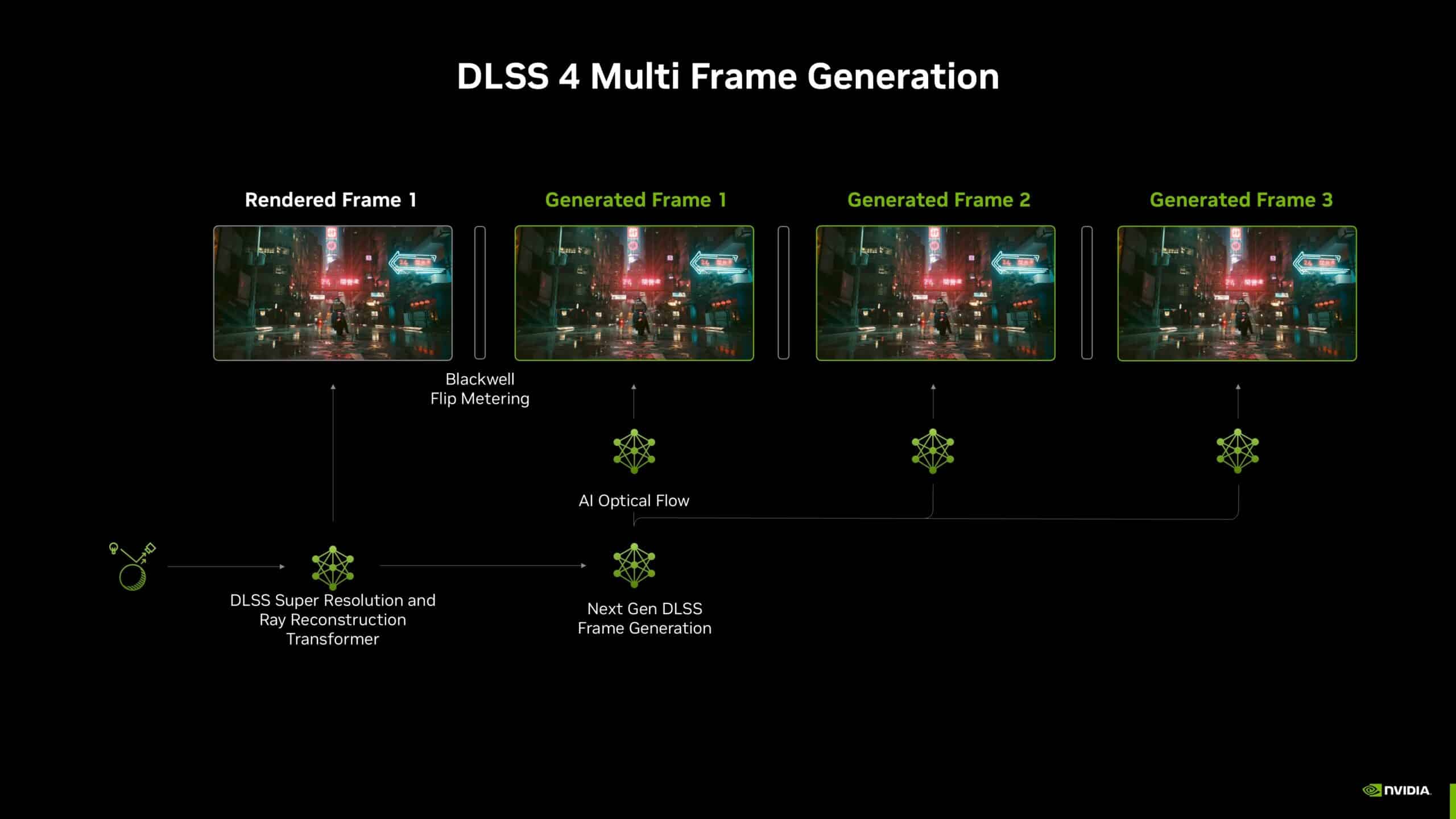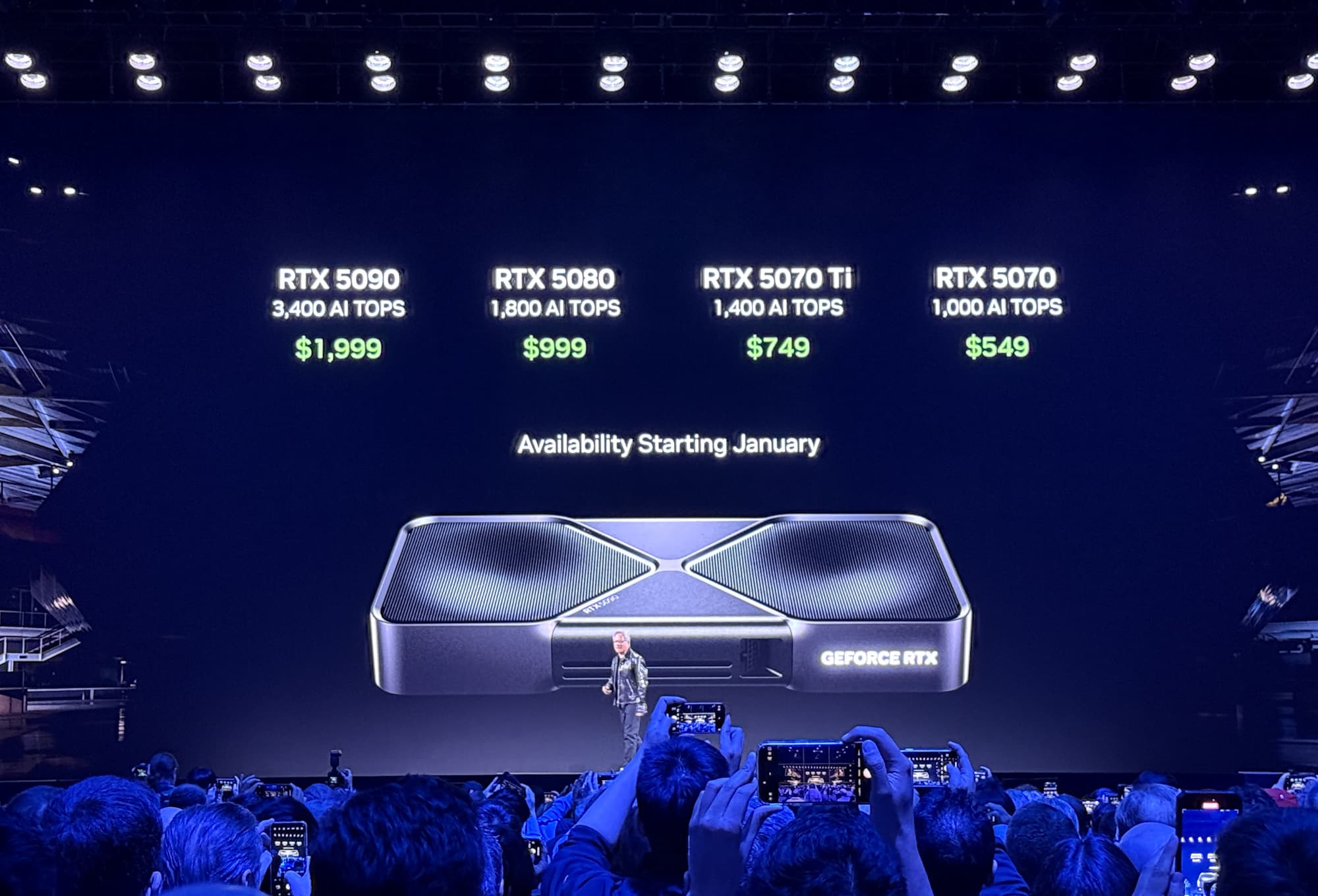The gaming landscape is set for a dramatic transformation as NVIDIA unveils its groundbreaking GeForce RTX 50 Series GPUs at CES 2025.
The gaming landscape is set for a dramatic transformation as NVIDIA unveils its groundbreaking GeForce RTX 50 Series GPUs at CES 2025. Built on the innovative Blackwell architecture, these new graphics cards promise to redefine gaming performance through advanced AI technologies, neural rendering, and unprecedented improvements in graphics quality.
UPDATE 1/23/25 – NVIDIA GeForece RTX 5090 Review Posted
 Power and Performance Leap
Power and Performance Leap
At the heart of this new generation lies the flagship GeForce RTX 5090, which features an impressive 92 billion transistors and delivers over 3,352 trillion AI operations per second and a whopping 32GB of GDDR7 Memory. This powerhouse GPU promises up to twice the performance of its predecessor, the RTX 4090, setting new standards for gaming. The RTX 50 Series marks yet another significant milestone for NVIDIA. The 50 Series is the first consumer GPU to support FP4 precision, doubling AI image generation performance for models like FLUX while enabling generative AI models to run locally with a smaller memory footprint than previous generations.
DLSS 4: Era of AI-Enhanced Gaming
With the 50 Series, NVIDIA has updated their DLSS technology, which leaps forward with DLSS 4, introducing Multi Frame Generation that can generate up to three additional frames for every rendered frame. According to NVIDIA, this breakthrough enables up to 8x performance improvement over traditional rendering while maintaining exceptional image quality. DLSS 4 Multi Frame Generation employs transformer models, the same architecture powering advanced AI systems like ChatGPT, to deliver improved temporal stability, reduced ghosting, and enhanced detail in motion. At launch, 75 games and applications will support DLSS with Multi Frame Generation, showcasing the broad industry adoption of this revolutionary technology.
Reflex 2: Latency be Gone
Another technology behind 50 Series strong gaming performance is Reflex 2, aimed to reduce gaming latency. Through its Frame Warp technology, NVIDIA reports Reflex 2 can reduce input lag by up to 75% compared to traditional rendering. This system updates rendered frames based on the latest mouse input just before display output, resulting in more responsive gameplay and improved competitive performance in multiplayer games. In games like Valorant, the technology achieves unprecedented low latency of under 3ms when running at 800+ FPS on the RTX 5090.
Neural Rendering and RTX Innovations
Another addition to NVIDIA’s long line of gaming and AI-related advancements is the introduction of RTX Neural Shaders, which may be the most significant innovation in computer graphics. This technology brings AI directly into the rendering pipeline, enabling film-quality materials and lighting in real-time games. RTX Neural Texture Compression uses AI to compress thousands of textures in less than a minute, saving up to 7x more VRAM than traditional block-compressed textures while maintaining the same visual quality. RTX Neural Materials accelerates complex shader processing by 5x, making it possible to render film-quality materials with multiple layers, such as porcelain and silk, at game-ready frame rates. The Neural Radiance Cache (NRC) uses AI to learn multi-bounce indirect lighting, inferring infinite bounces after the initial path-traced rays, delivering superior path-traced indirect lighting with better performance.
To create infinitely complex open worlds, NVIDIA has introduced RTX Mega Geometry, which addresses the challenge of exponentially increasing triangle counts in modern games. As scenes grow more complex with hundreds of millions of triangles, traditional rendering methods struggle with building the bounding volume hierarchy (BVH) for each frame. RTX Mega Geometry accelerates this process, making it possible to ray trace up to 100x more triangles than current standards. This technology intelligently updates clusters of triangles in batches on the GPU, reducing CPU overhead while increasing performance and image quality in ray-traced scenes.
Looking to the Future
NVIDIA’s RTX 50 Series represents more than just a generational leap in graphics hardware; it marks the beginning of a new era where AI and neural rendering fundamentally transform how games are experienced. With technologies like DLSS 4, Reflex 2, and RTX Neural Shaders, combined with groundbreaking features like FP4 precision and RTX Mega Geometry, NVIDIA is improving graphics performance and revolutionizing real-time rendering and gaming interaction. As developers harness these capabilities, gamers can look forward to more immersive, responsive, and visually stunning experiences that blur the line between virtual and reality.
UPDATE 1/23/25 – NVIDIA GeForece RTX 5090 Review Posted
Engage with StorageReview
Newsletter | YouTube | Podcast iTunes/Spotify | Instagram | Twitter | TikTok | RSS Feed

 Power and Performance Leap
Power and Performance Leap
